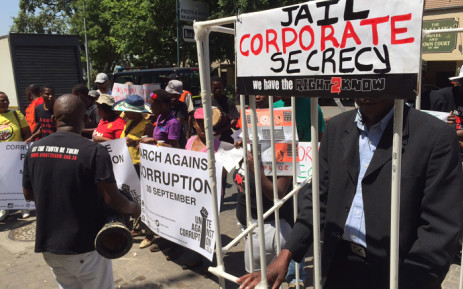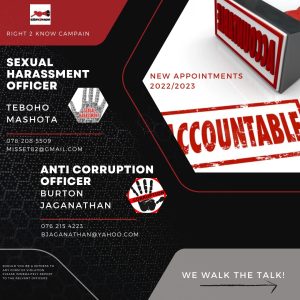Joint Statement: a programme of week-long localised actions on police brutality!
UPDATE: find details of pickets here.
We, as the United Front(UF), the National Union of Metalworkers of South Africa (Numsa), the Right2Know (R2K) Campaign, Marikana Support Campaign, African Diaspora Forum (ADF) and Thembelihle Crisis Committee; will coordinate a programme of weeklong localised actions aimed at reclaiming our rights such as the freedom not to be detained without trial, freedom from all forms of violence, freedom from torture, freedom of expression, the right to human dignity, our rights to privacy and the right to assemble, to demonstrate, to picket and to present petitions.
Starting with a picket outside the US consulate in Sandton on Wednesday 18 March to highlight police brutality against Afro-American communities, the action will move through the country; touching townships like Manenberg, Khayelitsha and Delft in Cape Town; Katlehong and Thembelihle in Gauteng. The action will also take place in small towns such as Thabong in Welkom; Whittlesea, Grahamstown and Peddie in the Eastern Cape. A memorial for the 21 people shot dead and 51 people injured or widowed in KwaLanga on 21 March 1985 will be held in Uitenhage. Symbolic tombstones for 44 people who have been killed by the police during protests since 2004 will be unveiled on Saturday 21 March in front of Johannesburg Central Police Station (previously called John Vorster Square). Two night vigils will also be held in Rustenburg for the miners who were massacred in Marikana.
Why are we embarking on this programme of action?
While political and economic elites will on the eve of Human Rights Day mouth pious platitudes about how our constitution is the best in the world, many communities strongly feel that their rights are being violated. The problem of police violence against protests is intensifying as the number industrial and community protests grow. Unions and other movements are complaining about the police use of excessive force, as well as intelligence harassment of activists.
Although cognisant of the violation of other civil and socio-economic rights, it is the freedom not to be detained without trial, the freedom from all forms of violence, the freedom from torture, the freedom of expression, the right to human dignity, our rights to privacy and the right to assemble, to demonstrate, to picket and to present petitions; that our programme will focus on.
As a wave of protests engulfed the country, the growing problem of police brutality was starkly illustrated by the police killing of 17-year old Tebogo Mkhonza. Then in 2011, activist Andries Tatane was killed by a police rubber bullet. In 2012, the massacre of mineworkers in Marikana pointed to the fact that police violence had become a systemic problem of the policing landscape. Over the past two decades, there has been growing evidence of a convergence of military and civilian policing functions, and more militarised responses to domestic problems.
The indicators of this militarisation include the increasing use of the military in internal security matters, the growth in the establishment and deployment of elite police units that are modelled after military special operations units and that are paramilitary in nature, and the application of military models to domestic policing functions.
The joint deployment of the military and the police are operational indicators of militarisation. The post-apartheid White Paper on Defence rejected a domestic role for the military on the grounds that this was a hallmark of repressive regimes, but the country’s current political leadership appears intent on reviewing this decision. Yet no public analysis has been conducted of the frequency of these deployments, or their necessity.
Centralisation is another indicator of militarised policing, because it allows for greater political control to ensure rapid deployment, while reducing local control. A good example of how extraordinary security measures become normalised is that a ‘security legacy’ of the 2010 World Cup, the National Joint Intelligence and Operations Structure (Natjoints), appears to have become a permanent feature of the policing landscape. This body brings together the police, the intelligence agencies and various government departments, co-ordinating the joint deployment of the police and the military, and has grown provincial legs as well. In September 2013, Natjoints announced that its newly created ‘stability committee’ was monitoring and fast-tracking prosecutions, which suggests a more centralised approach to the protests, and an escalation of disruptive protests to the level of priority crimes.
The shift to intelligence-led policing:
Another form of policing has also been in development in South Africa and elsewhere, namely intelligence-led policing. As its name suggests, this form of policing uses risk assessment as its main tool to direct policing decisions about where and how to intervene. It is more recent than paramilitary policing, as it was conceptualised in the 1990s, but it really gained currency after 9/11. Given the highly-secretive nature of intelligence work, the problem with intelligence-led policing is that human rights abuses may not disappear, they may merely become less visible. Intelligence-led policing elsewhere has led to profiling of individuals and unaccountable harassment of activists.
The draft White Paper on the Police is silent on intelligence-led policing, as well as the role of the paramilitary units and police militarisation in its more substantial sense.
What then are our demands?
As the organisations involved in this campaign we demand the following:
- The respect and protection by the police of people’s right to protest, freedom of assembly and freedom of expression.
- The complete removal of the paramilitary units from public order policing. The training of police on how to deal with peaceful protests and how to de-escalate violence is urgently required.
- An independent investigation into the true extent of police militarisation, and substantial demilitarisation of the police, including the reversal of all operational, cultural and organisational and material indicators of demilitarisation, such as technology transfer from the military to the police.
- The state needs to investigate why there are systemic investigatory and prosecutorial failings when it comes to police involved in brutality. Police must abide by relevant laws and regulations
- Police personnel implicated in all abuses against protestors, including protest-related murders, assaults, excessive use of force, illegal use of firearms should be charged and brought to justice.
- Greater accountability of the intelligence capacities of the police, including greater transparency about their activities. There should be an end to the surveillance and harassment of activists (and their families) by the police.
- Resisting the public resource grab by the police for protest policing, and arguing that are overstating the extent of violent protests. We should not be funding our own oppression.
- A return to genuine community policing as a strategy to reduce levels of police violence and to stop the drift towards intelligence-led policing. We demand a full community and public inclusion and participation in the review of the policy on policing, safety and security.
- Direct political work between police unions/rank-and-file police and social movements with an expressed aim to inculcate a culture that police are workers and should not turn their guns on strikers and protesters.
- The full release of the Farlam Commission report and justice for Marikana miners.
Conclusion:
While at the dawn of democracy we assumed that it is within the capacity of the police to ‘serve and protect’, the experience of the last few years has taught us that police are not a neutral force. Police violence may not be just an aberration or acts of a few “rogue cops” but integral to the systemic role of the police in class society. Police brutality is a symptom of a more systematic war on the poor.
Whereas in expansionary periods, the police can afford to experiment with touchy-feely forms of policing, like community policing, but in recessionary periods, when the chips are down, the capitalist system needs to make sure that the police are on its side. The police’s semi-autonomy is eroded and they become the enforcers of capitalist social relations. This shift was expressed most starkly in Marikana, where the police used strike violence as a pretext to act as security guards for the mining companies.
As the organisations represented at this conference we commit ourselves to find short and medium term solutions to police brutality through a struggle around the 10 demands outlined above. We also dedicate ourselves to discuss the tough questions of the role of police in a class-divided society.
As part of these discussions we want to express our concerns with what is a deliberate campaign to render crime and justice institutions such as the Hawks, Independent Police Investigative Directorate (IPID) and National Prosecuting Authority (NPA) dysfunctional.



